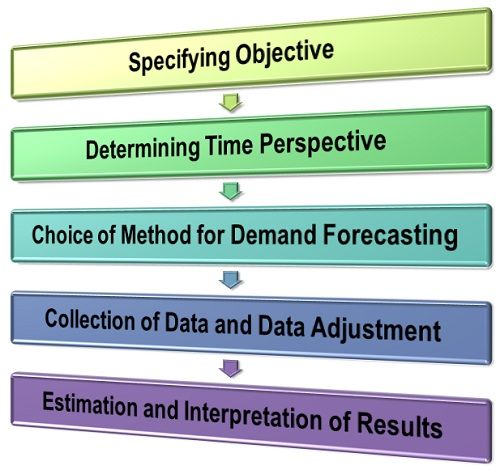Definition: Demand Forecasting is a systematic process of predicting the future demand for a firm’s product. Simply, estimating the potential demand for a product in the future is called as demand forecasting.
The demand forecasting finds its significance where the large-scale production is involved. Such firms may often face difficulties in obtaining a fairly accurate estimation of future demand. Thus, it is essential to forecast demand systematically and scientifically to arrive at desired objective. Therefore, the following steps are taken to facilitate a systematic demand forecasting:
- Specifying the Objective: The objective for which the demand forecasting is to be done must be clearly specified. The objective may be defined in terms of; long-term or short-term demand, the whole or only the segment of a market for a firm’s product, overall demand for a product or only for a firm’s own product, firm’s overall market share in the industry, etc. The objective of the demand must be determined before the process of demand forecasting begins as it will give direction to the whole research.
- Determining the Time Perspective: On the basis of the objective set, the demand forecast can either be for a short-period, say for the next 2-3 year or a long period. While forecasting demand for a short period (2-3 years), many determinants of demand can be assumed to remain constant or do not change significantly. While in the long run, the determinants of demand may change significantly. Thus, it is essential to define the time perspective, i.e., the time duration for which the demand is to be forecasted.
- Making a Choice of Method for Demand Forecasting: Once the objective is set and the time perspective has been specified the method for performing the forecast is selected. There are several methods of demand forecasting falling under two categories; survey methods and statistical methods.The Survey method includes consumer survey and opinion poll methods, and the statistical methods include trend projection, barometric and econometric methods. Each method varies from one another in terms of the purpose of forecasting, type of data required, availability of data and time frame within which the demand is to be forecasted. Thus, the forecaster must select the method that best suits his requirement.
- Collection of Data and Data Adjustment: Once the method is decided upon, the next step is to collect the required data either primary or secondary or both. The primary data are the first-hand data which has never been collected before. While the secondary data are the data already available. Often, data required is not available and hence the data are to be adjusted, even manipulated, if necessary with a purpose to build a data consistent with the data required.
- Estimation and Interpretation of Results: Once the required data are collected and the demand forecasting method is finalized, the final step is to estimate the demand for the predefined years of the period. Usually, the estimates appear in the form of equations, and the result is interpreted and presented in the easy and usable form.
Thus, the objective of demand forecasting can only be achieved only if these steps are followed systematically.


Ammu says
Thanks for the article
Sreehari Shaji says
Helpful to me.
Kunal says
Thanks I got project on it and it is really helpful